Related Research Articles
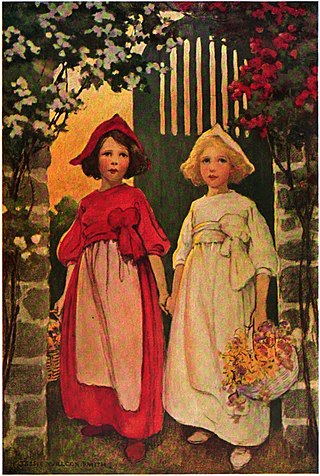
"Snow-White and Rose-Red" is a German fairy tale. The best-known version is the one collected by the Brothers Grimm in 1837 in the third edition of their collection Grimm's Fairy Tales. An older, somewhat shorter version, "The Ungrateful Dwarf", was written by Caroline Stahl (1776–1837). Indeed, that appears to be the oldest variant; no previous oral version is known, although several have been collected since its publication in 1818. Oral versions are very limited regionally. The tale is of Aarne-Thompson type 426.
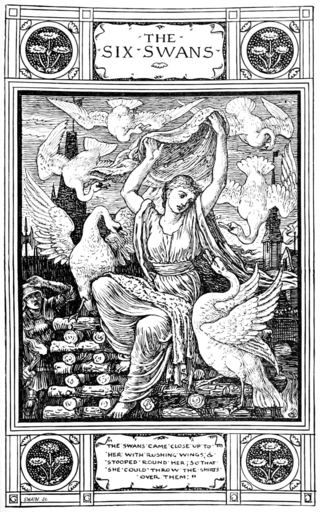
"The Six Swans" is a German fairy tale collected by the Brothers Grimm in Grimm's Fairy Tales in 1812. It is of Aarne–Thompson type 451, commonly found throughout Europe. Other tales of this type include The Seven Ravens, The Twelve Wild Ducks, Udea and her Seven Brothers, The Wild Swans, and The Twelve Brothers. Andrew Lang included a variant of the tale in The Yellow Fairy Book.
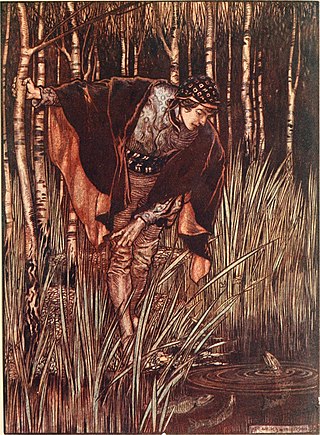
"The White Snake" is a German fairy tale collected by the Brothers Grimm and published in Grimm's Fairy Tales. It is of Aarne–Thompson type 673, and includes an episode of type 554.

"The Three Spinners" is a German fairy tale collected by the Brothers Grimm in Grimm's Fairy Tales. It is Aarne–Thompson type 501, which is widespread throughout Europe.
Tatterhood is a Norwegian fairy tale collected by Peter Christen Asbjørnsen and Jørgen Moe.

"Maid Maleen" is a German fairy tale collected by the Brothers Grimm, number 198.
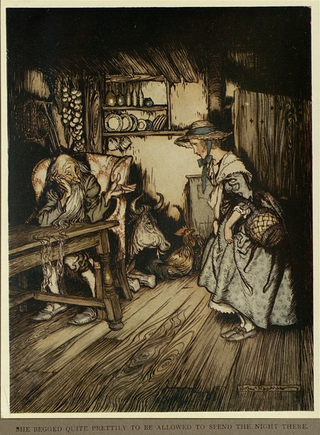
"The Hut in the Forest" is a German fairy tale collected by the Brothers Grimm. Andrew Lang included it in The Pink Fairy Book (1897). It is Aarne-Thompson type 431.

"The Old Woman in the Wood" is a German fairy tale collected by the Brothers Grimm, tale number 123. It is Aarne-Thompson type 442.
"The Glass Coffin" is a German fairy tale collected by the Brothers Grimm, tale number 163. Andrew Lang included it in The Green Fairy Book as The Crystal Coffin.
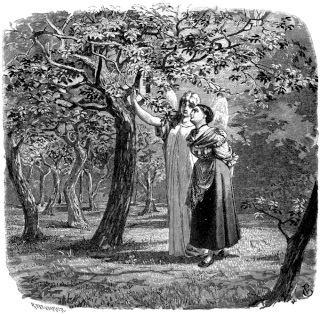
"The Girl Without Hands" or "The helpless Maiden" or "The Armless Maiden" is a German fairy tale collected by the Brothers Grimm. It is tale number 31 and was first published in the 1812 edition of Children's and Household Tales. The story was revised by the Grimm brothers over the years, and the final version was published in the 7th edition of Children's and Household Tales in 1857. It is Aarne-Thompson type 706.
The Armless Maiden is a Russian fairy tale collected by Alexander Afanasyev in Narodnye russkie skazki.

The Lute Player, The Tsaritsa Harpist or The Tsaritsa who Played the Gusli, is a Russian fairy tale. It was published by Alexander Afanasyev in his collection Russian Fairy Tales, as number 338. Andrew Lang included it in The Violet Fairy Book (1901).
"The Four Skillful Brothers" is a German fairy tale collected by the Brothers Grimm. It is Aarne-Thompson type 653.
Biancabella and the Snake is an Italian literary fairy tale written by Giovanni Francesco Straparola in The Facetious Nights of Straparola.
Sapia Liccarda is an Italian literary fairy tale written by Giambattista Basile in his 1634 work, the Pentamerone. It is not known whether he had a specific source, either literary or oral, for this tale.

"The Peasant's Wise Daughter", "The Peasant's Clever Daughter" or "The Clever Lass" is a German fairy tale collected by the Brothers Grimm in Grimm's Fairy Tales as tale number 94. It has also spread into Bohemia and Božena Němcová included it into her collection of Czech national folk tales in 1846.
"The Ass", "The Donkey", or "The Little Donkey" is a German fairy tale collected by Brothers Grimm compiled in the Grimm's Fairy Tales.
The Raven is an Italian literary fairy tale written by Giambattista Basile in his 1634 work, the Pentamerone. The story is a man winning a bride for his brother the king, and then having to protect the couple from perils that he can not tell anyone about, without being turned to stone.
Fairer-than-a-Fairy or More Beautiful Than Fairy is a literary fairy tale by Charlotte-Rose de Caumont de La Force in 1698.
In folkloristics, "The Animal as Bridegroom" refers to a group of folk and fairy tales about a human woman marrying or being betrothed to an animal. The animal is revealed to be a human prince in disguise or under a curse. Most of these tales are grouped in the international system of Aarne-Thompson-Uther Index under type ATU 425, "The Search for the Lost Husband". Some subtypes exist in the international classification as independent stories, but they sometimes don't adhere to a fixed typing.
References
- ↑ Jack Zipes, The Great Fairy Tale Tradition: From Straparola and Basile to the Brothers Grimm, p 512, ISBN 0-393-97636-X
- ↑ D. L. Ashliman, "Incest in Indo-European Folktales"
- ↑ "The Grimms' Notes For the Tale"
- ↑ Heidi Anne Heiner, "Tales Similar to the Girl Without Hands" Archived 2007-02-05 at the Wayback Machine
- ↑ Maria Tatar, Off with Their Heads! p. 121-2 ISBN 0-691-06943-3
- ↑ Stith Thompson, The Folktale, p 121-2, University of California Press, Berkeley Los Angeles London, 1977
- ↑ Stith Thompson, The Folktale, p 122-3, University of California Press, Berkeley Los Angeles London, 1977